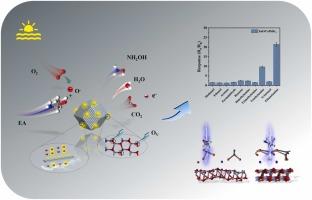MOFs-derived ZnO dodecahedrons decorated with perovskite CsPbBr3 quantum dots for efficient detection of ethanolamine
IF 3.7
1区 化学
Q1 CHEMISTRY, ANALYTICAL
引用次数: 0
Abstract
Ethanolamine (EA), a reactive and volatile organic compound (VOC) widely used in chemical and environmental applications, presents significant detection challenges due to its strong alkalinity and high volatility. In this study, a heterostructured system composed of ZIF-8 derived zinc oxide (ZnO) and perovskite CsPbBr3 quantum dots (QDs) was successfully constructed, achieving efficient detection of EA. Compared with pure ZnO, the detection performance of the ZnO/CsPbBr3 composite for EA has been significantly improved. The experimental results demonstrate that the sensor based on this composite exhibits a high response value of 21.5 toward EA at the optimal operating temperature of 180 ℃, with the response/recovery time being reduced from 7/9 s to 4/7 s. Moreover, the ZnO/CsPbBr3 composite exhibits good reproducibility and a positive linear response relationship. A series of tests show that the improvement of the gas-sensing performance of the ZnO/CsPbBr3 composite is attributed to the excellent photoelectric properties of CsPbBr3 QDs, the formation of the heterostructure, and the dual-oxygen cooperative effect. Finally, the molecular mechanism underlying the performance improvement of the ZnO/CsPbBr3 composite was comprehensively elucidated at the electronic structure level through density functional theory (DFT) calculation. This study provides certain research ideas for the development of high-performance EA sensor.

用钙钛矿CsPbBr3量子点修饰的mfs衍生的ZnO十二面体用于乙醇胺的高效检测
乙醇胺(EA)是一种广泛应用于化学和环境领域的活性挥发性有机化合物(VOC),由于其强碱性和高挥发性,给检测带来了很大的挑战。本研究成功构建了由ZIF-8衍生氧化锌(ZnO)和钙钛矿CsPbBr3量子点(QDs)组成的异质结构体系,实现了对EA的高效检测。与纯ZnO相比,ZnO/CsPbBr3复合材料对EA的检测性能有了显著提高。实验结果表明,在180℃的最佳工作温度下,基于该复合材料的传感器对EA的响应值高达21.5,响应/恢复时间从7/9 s缩短到4/7 s。此外,ZnO/CsPbBr3复合材料具有良好的重现性和正线性响应关系。一系列测试表明,ZnO/CsPbBr3复合材料气敏性能的提高主要归功于CsPbBr3量子点优异的光电性能、异质结构的形成以及双氧协同效应。最后,通过密度泛函理论(DFT)计算,在电子结构水平上全面阐明了ZnO/CsPbBr3复合材料性能提升的分子机制。本研究为高性能EA传感器的开发提供了一定的研究思路。
本文章由计算机程序翻译,如有差异,请以英文原文为准。
求助全文
约1分钟内获得全文
求助全文
来源期刊

Sensors and Actuators B: Chemical
工程技术-电化学
CiteScore
14.60
自引率
11.90%
发文量
1776
审稿时长
3.2 months
期刊介绍:
Sensors & Actuators, B: Chemical is an international journal focused on the research and development of chemical transducers. It covers chemical sensors and biosensors, chemical actuators, and analytical microsystems. The journal is interdisciplinary, aiming to publish original works showcasing substantial advancements beyond the current state of the art in these fields, with practical applicability to solving meaningful analytical problems. Review articles are accepted by invitation from an Editor of the journal.
 求助内容:
求助内容: 应助结果提醒方式:
应助结果提醒方式:


